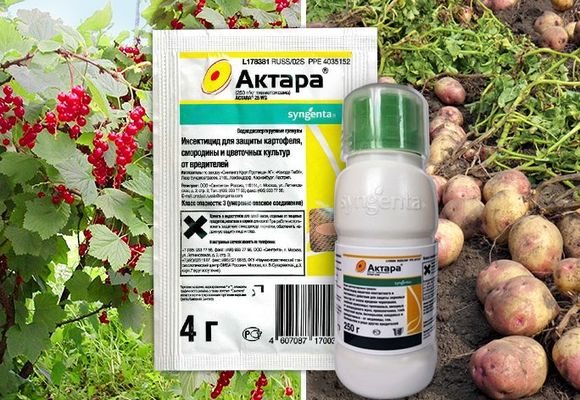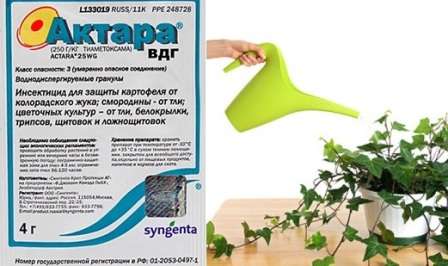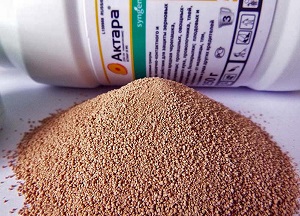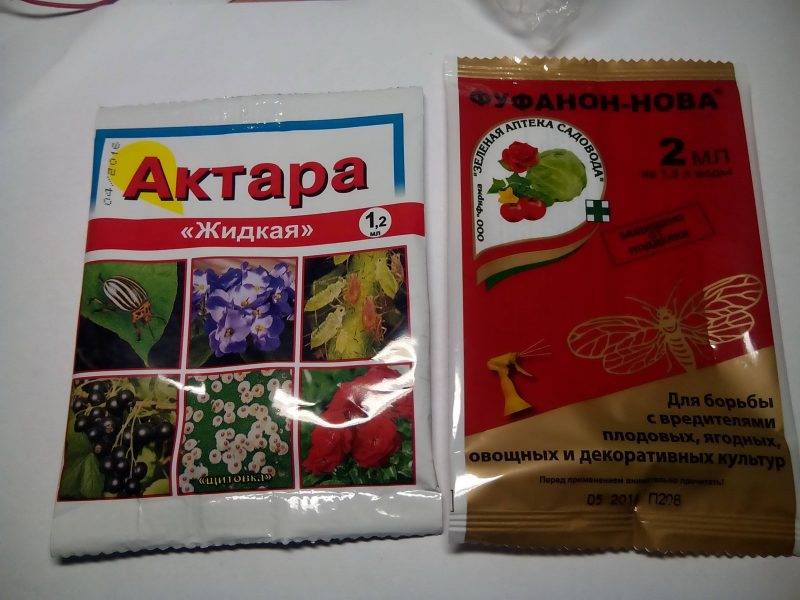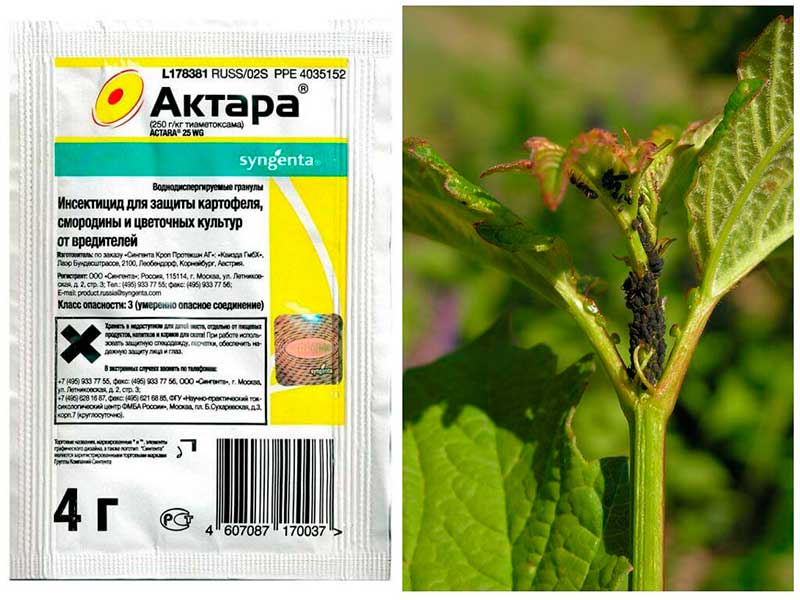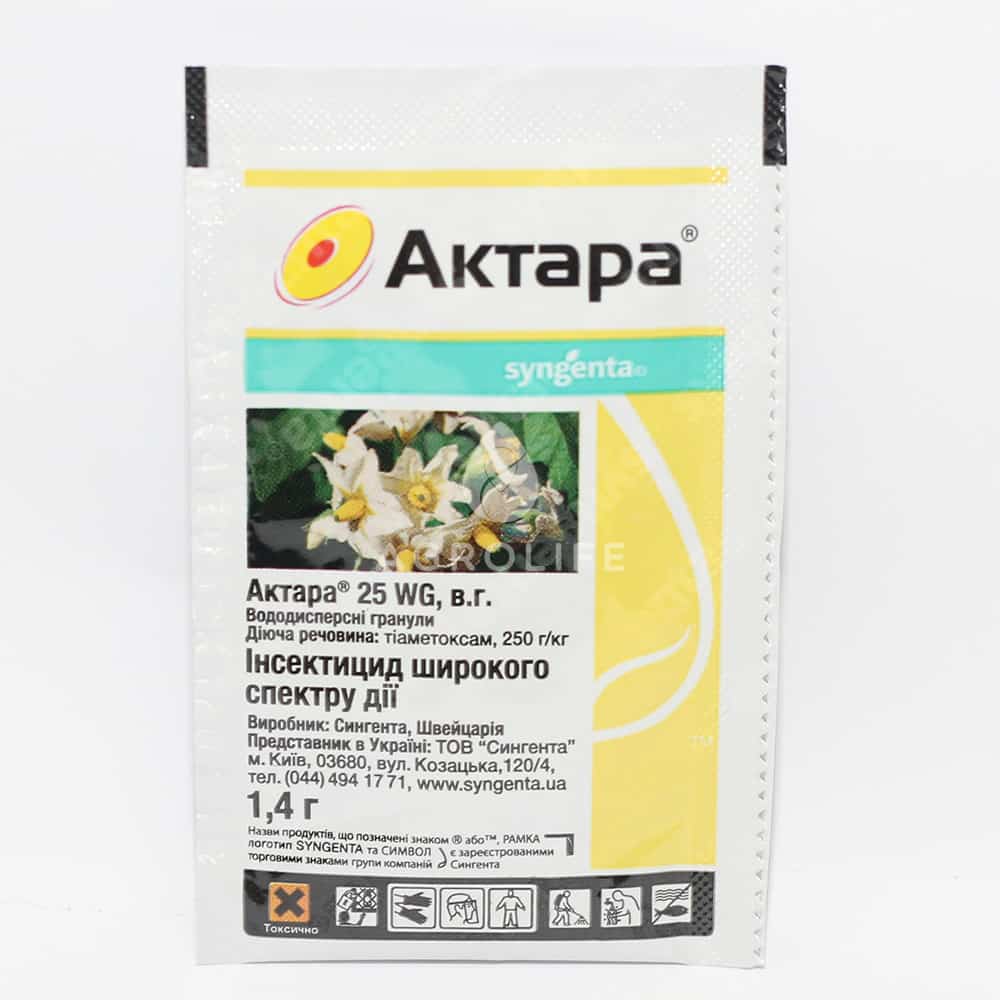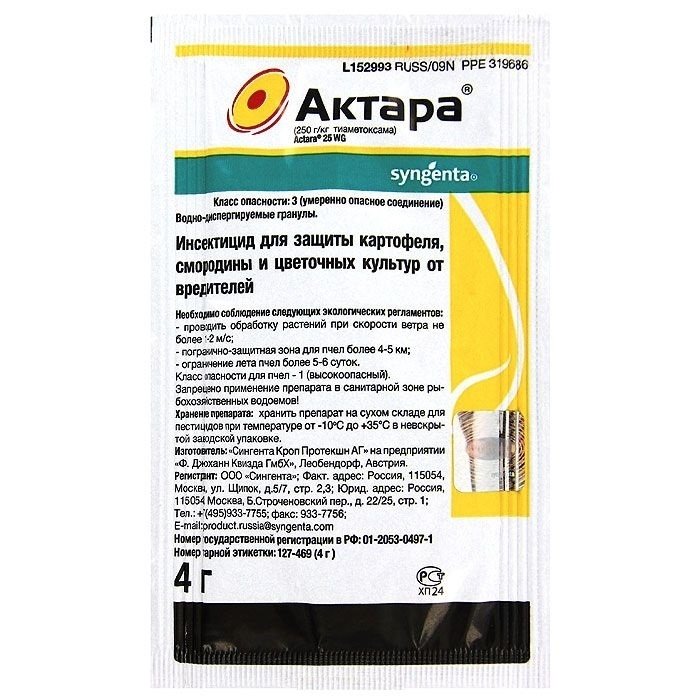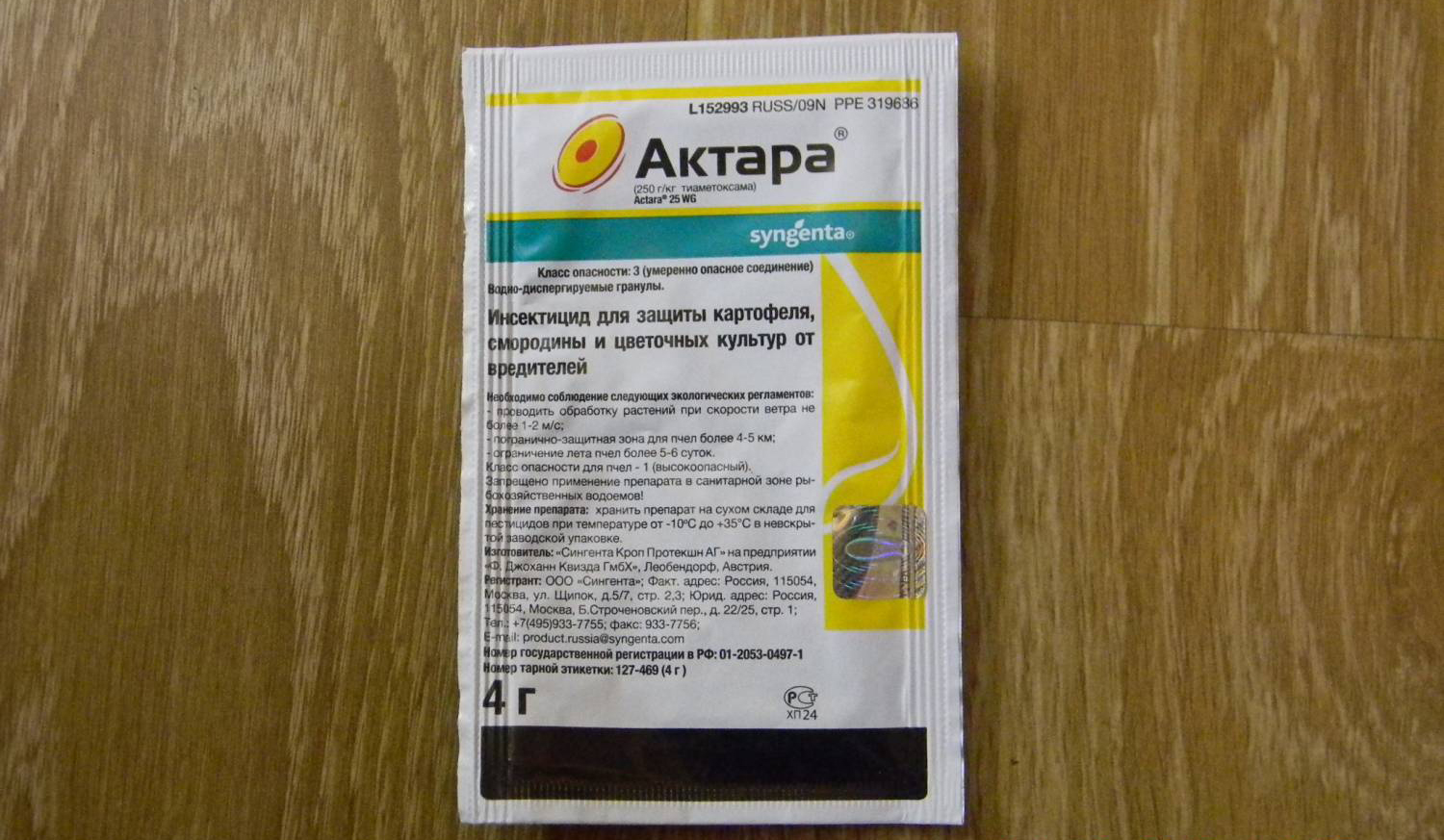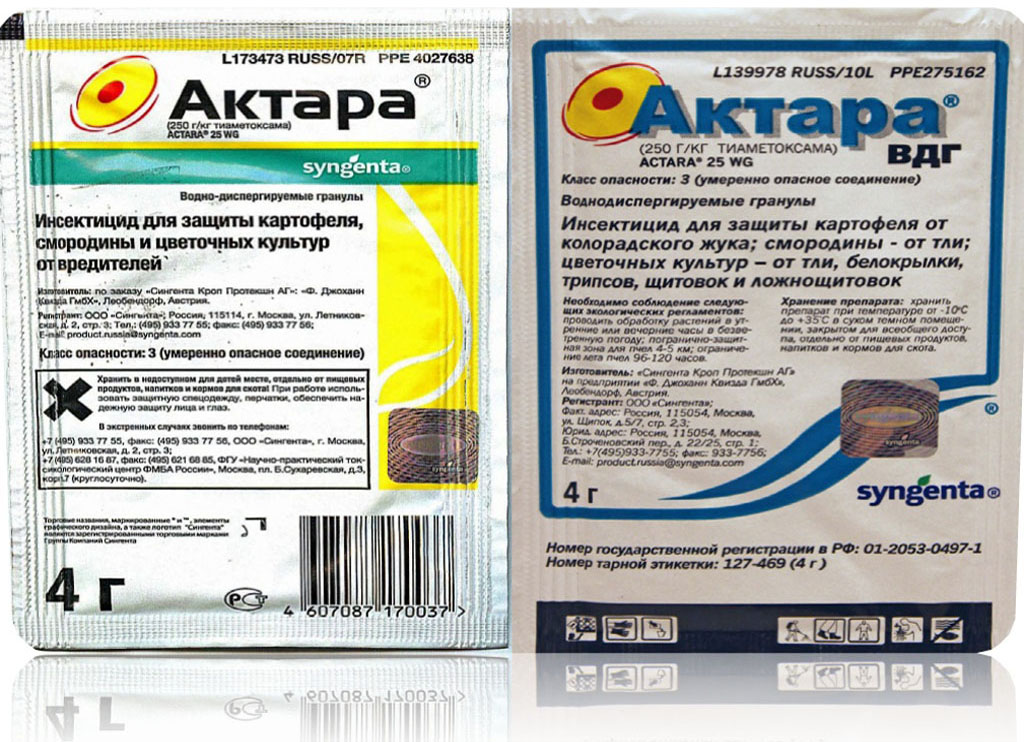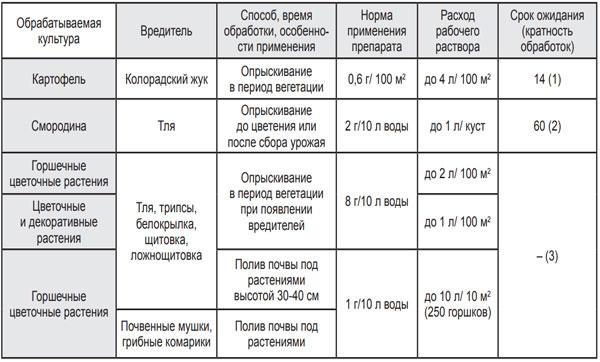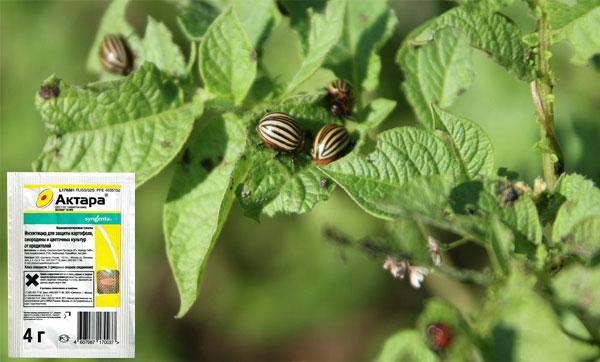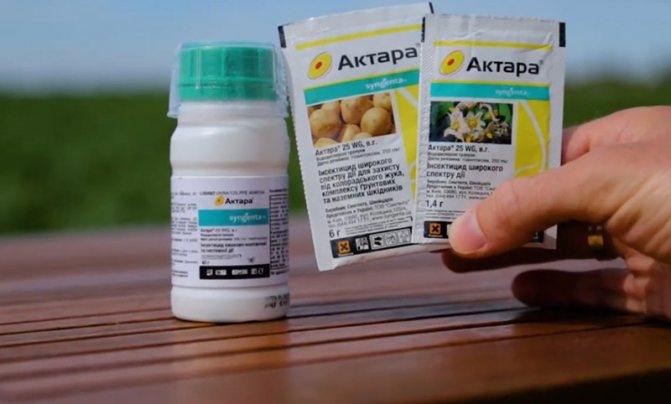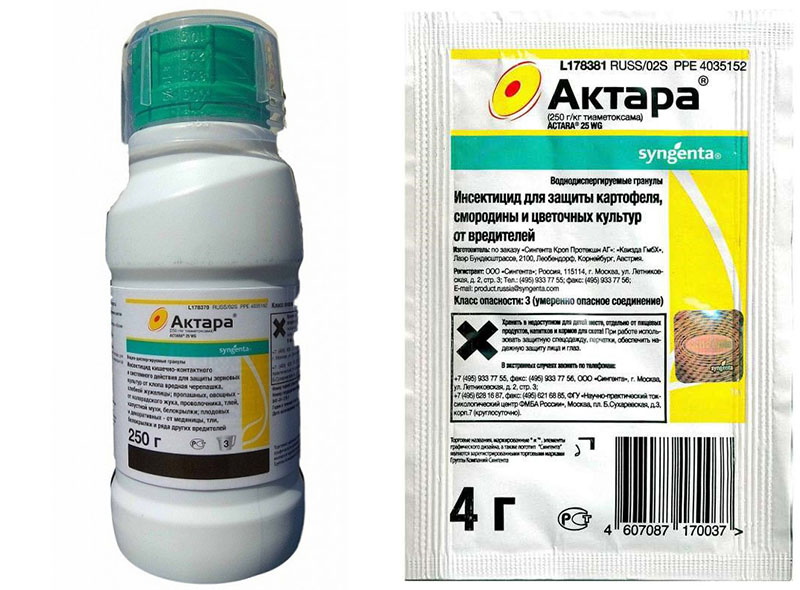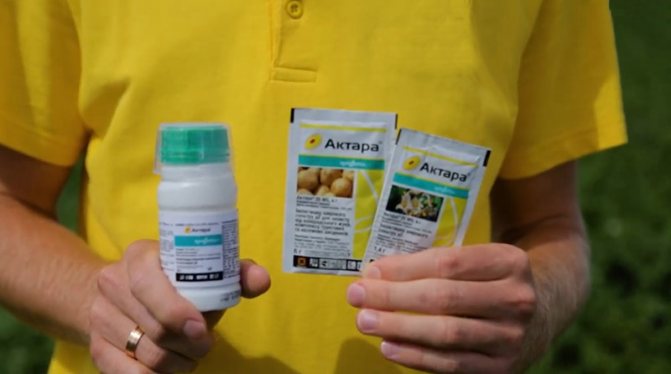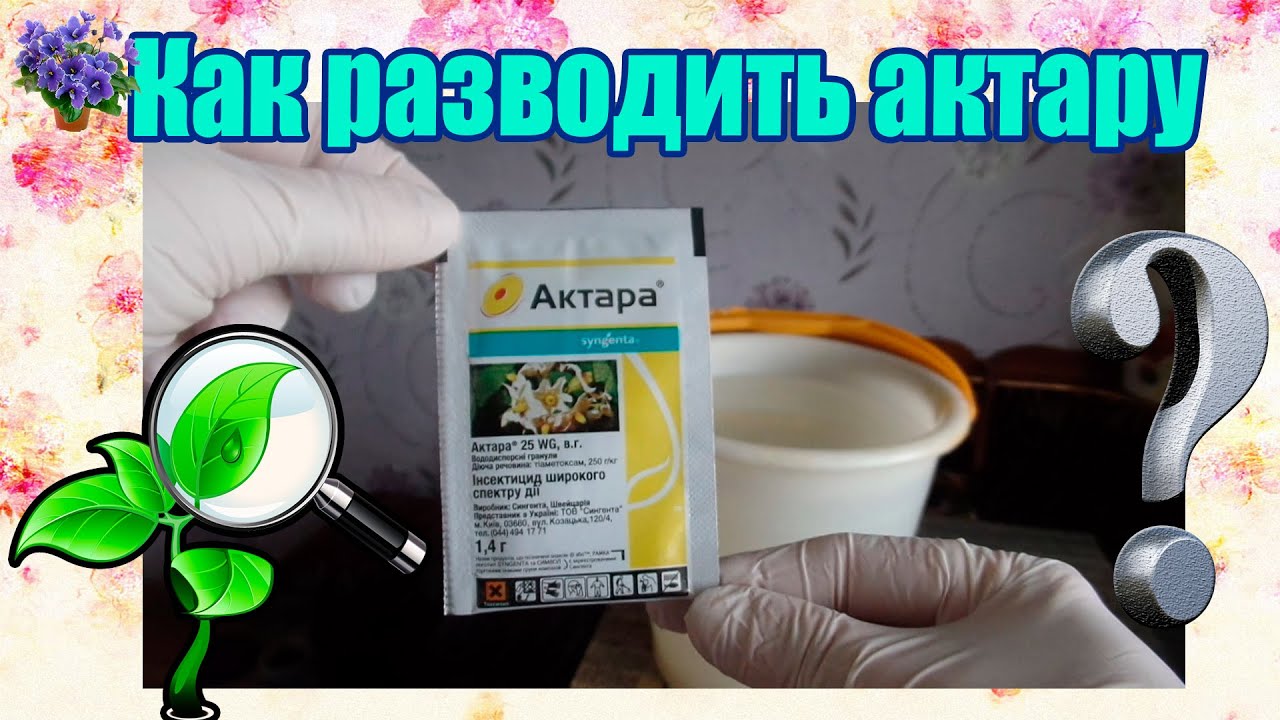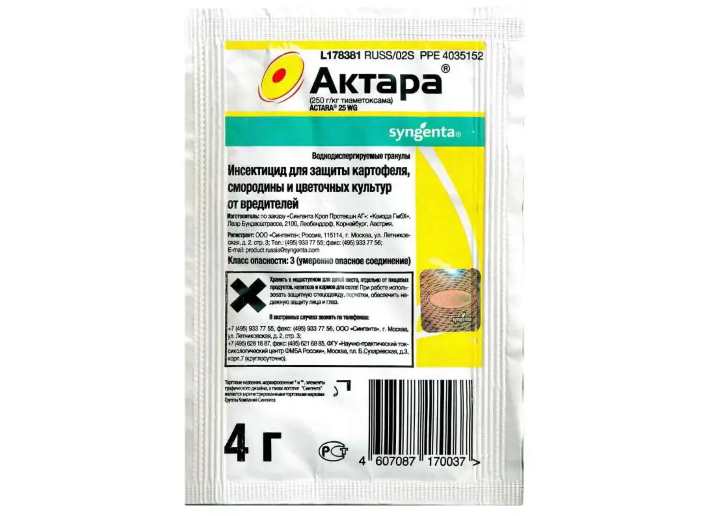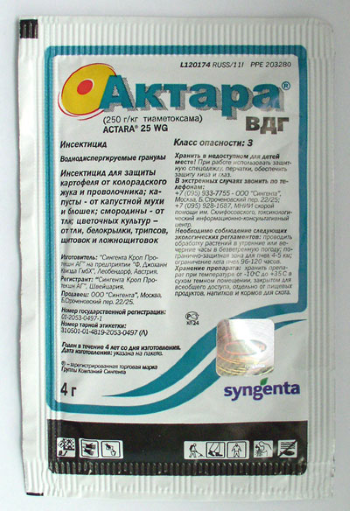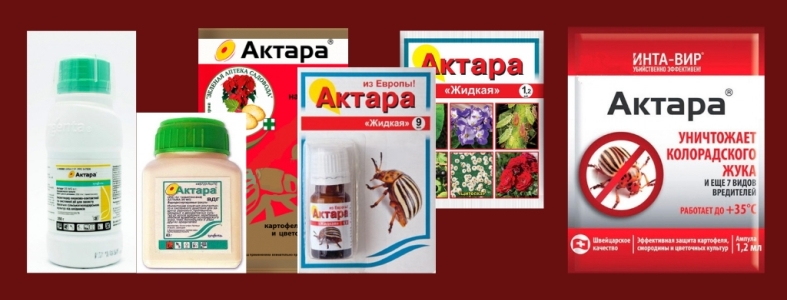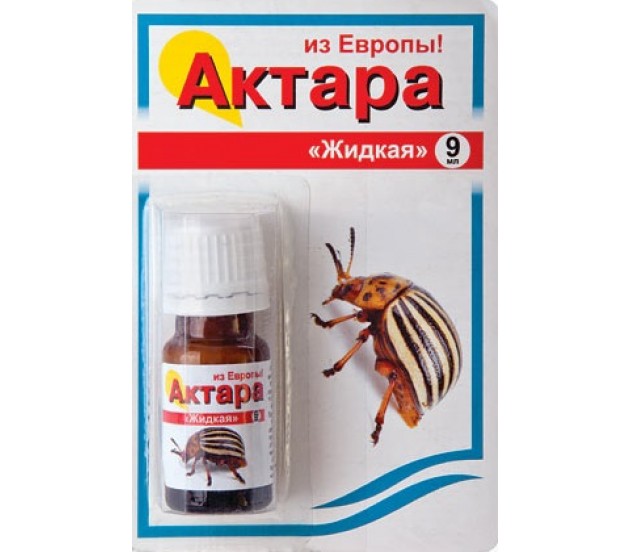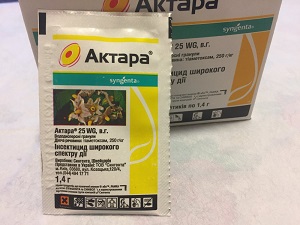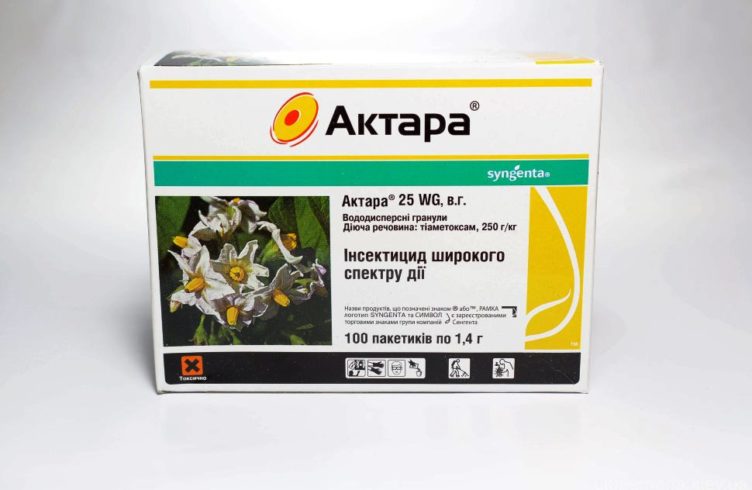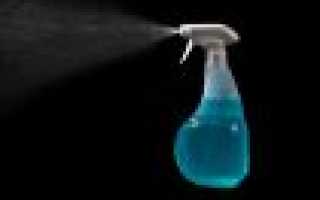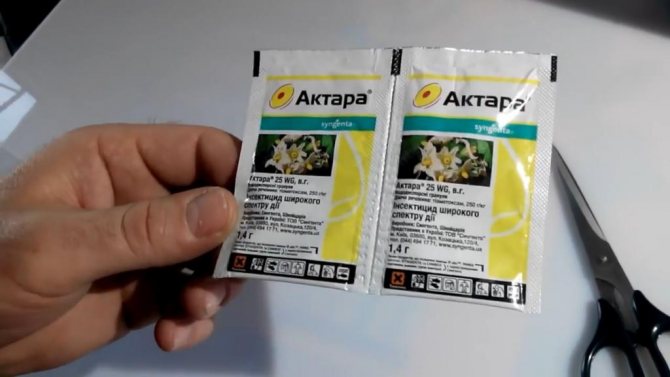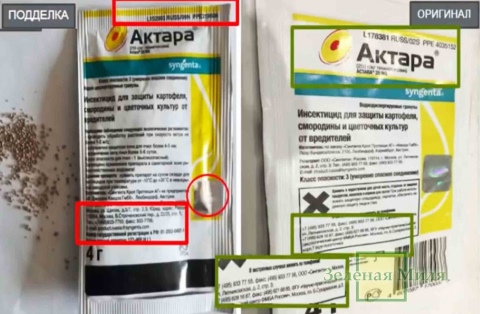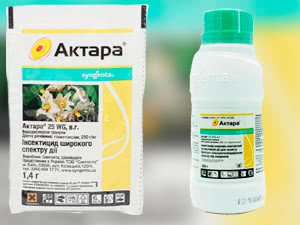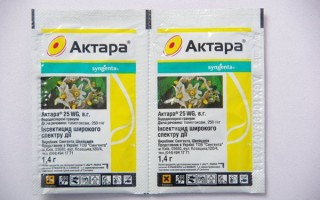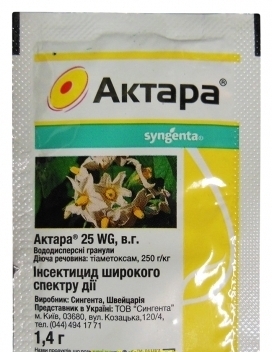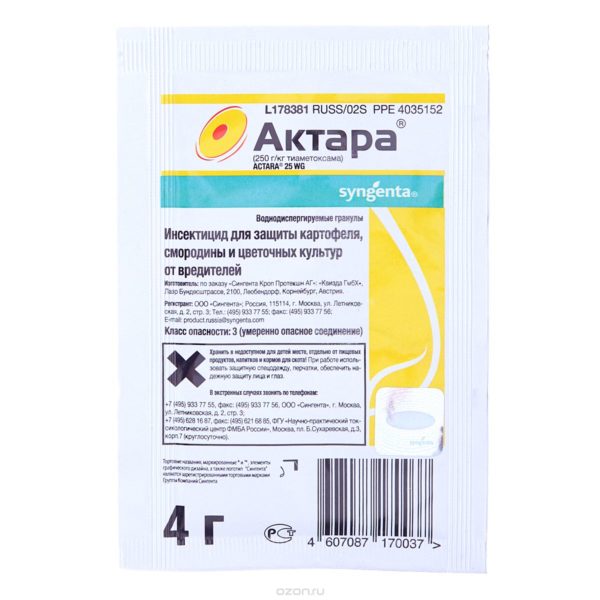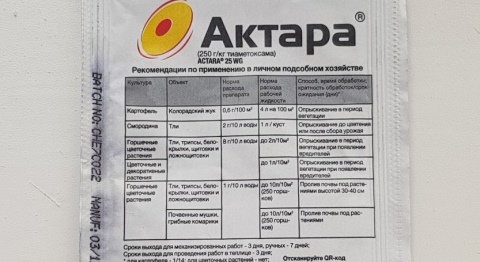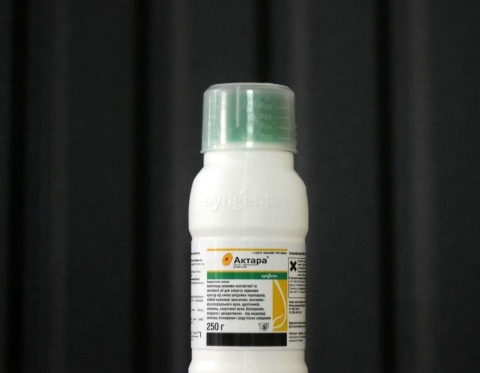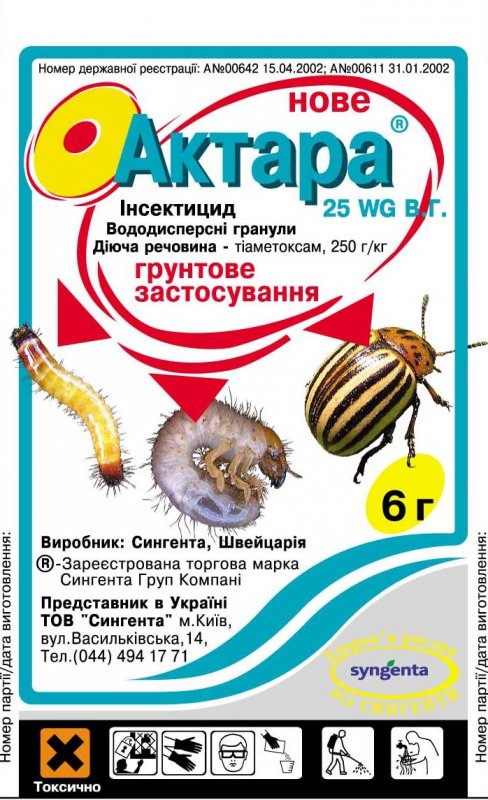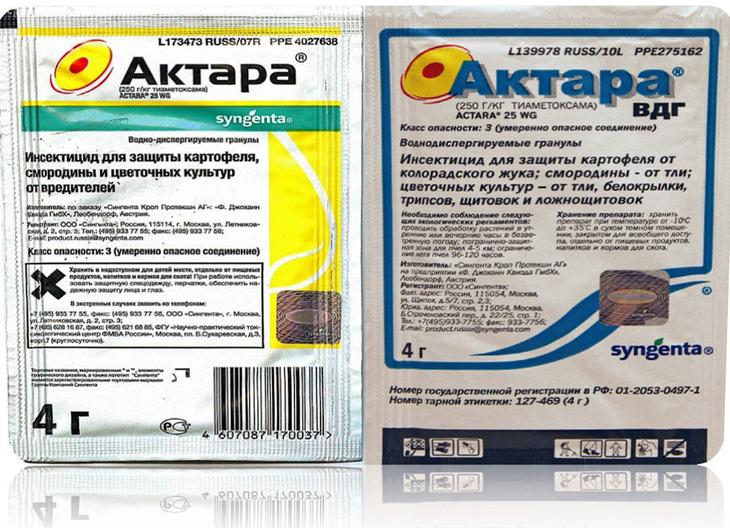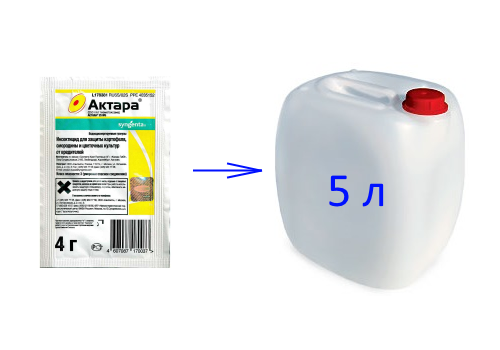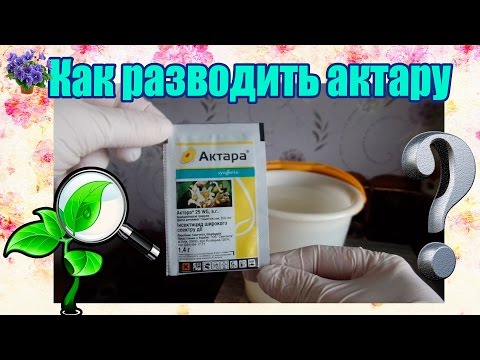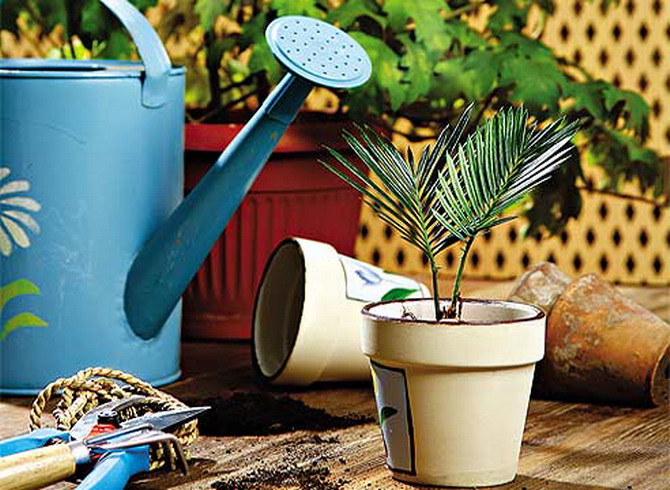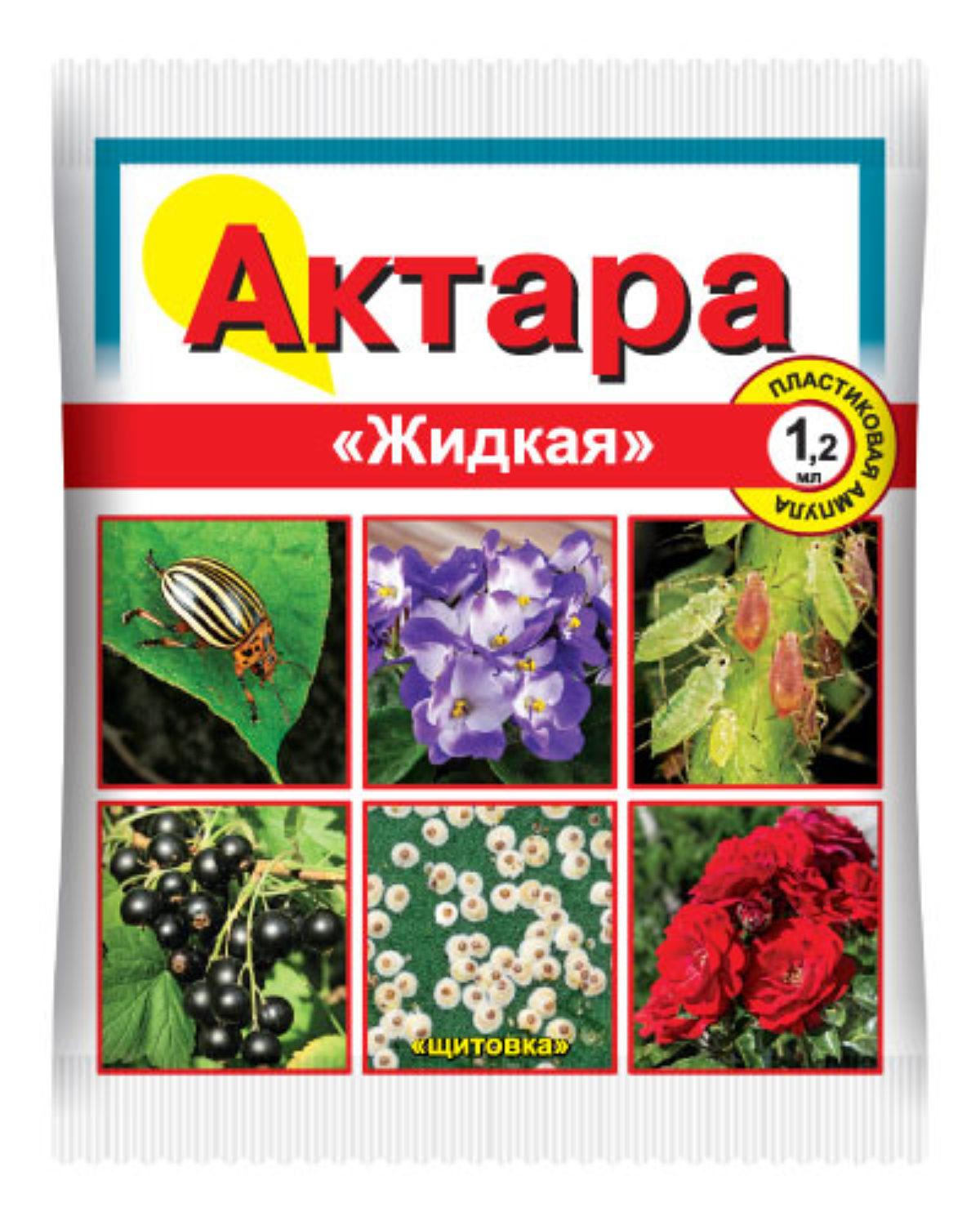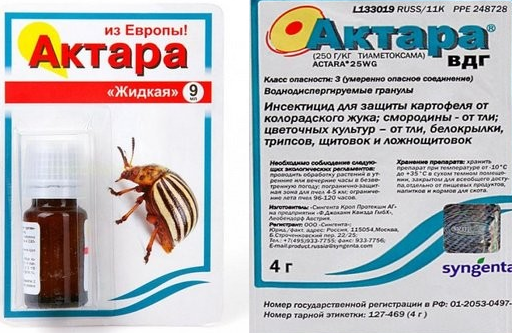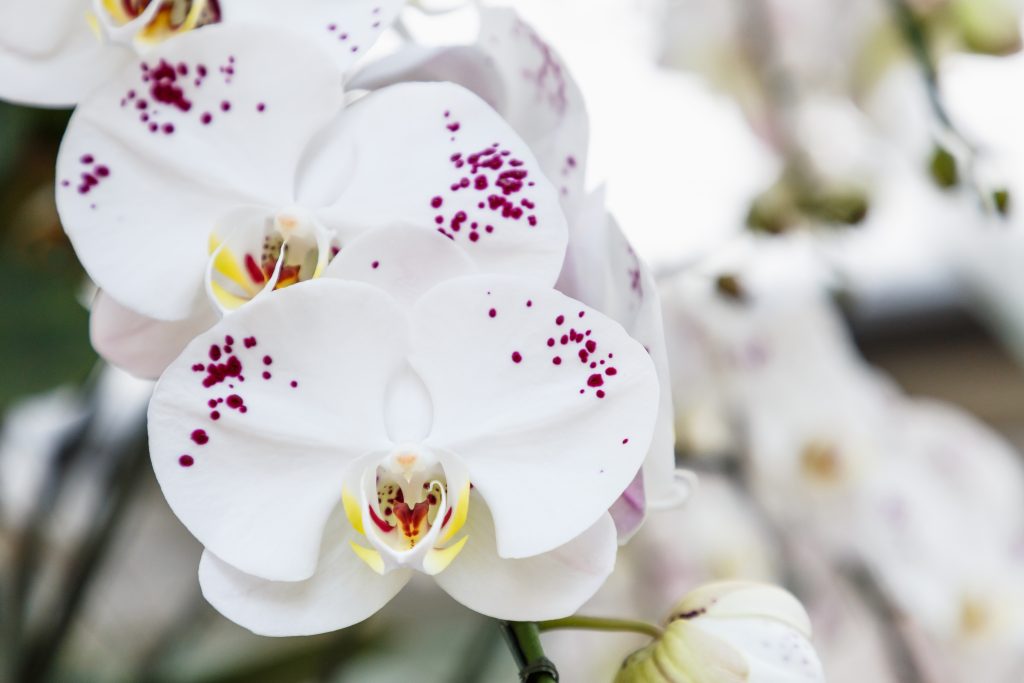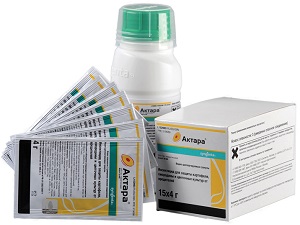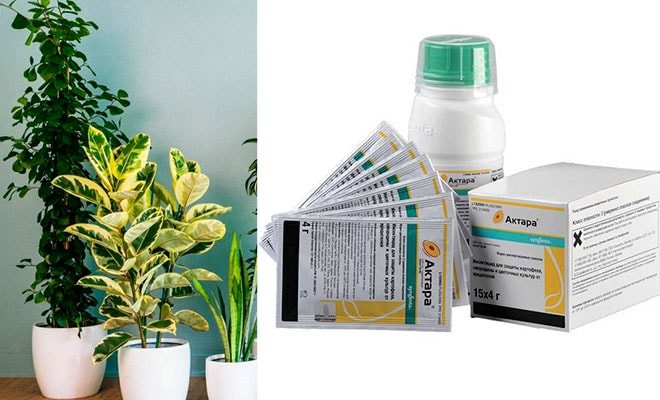Aktara: instructions for use for different types of crops
The package of the insecticidal preparation should be opened only in an open space, using a respirator and other personal protective equipment. The dosage of Aktara for preparing a working solution, the time when to process crops and processing characteristics depend on the specific type of plants.
Vegetable crops
Aktara is widely used for the destruction of various pests of garden crops. The proportions for preparing an insecticidal solution depend on the type of plant:
- For potatoes - 2 packets of Aktara weighing 1.4 g each must be diluted in 2 buckets of water. When using ampoules of 1.2 ml, 2 buckets of water are taken for each ampoule. A bucket of working solution is sufficient for treating 200 square meters of land. Processing is carried out once.
- For cucumbers - 2 g of Aktara is diluted in 10 liters of water, the working solution is enough for 200 square meters of a vegetable garden. The beds are processed once a week.
- White cabbage - the solution is prepared similarly to cucumbers, the beds are processed by spraying. In case of severe pest damage, the dosage is increased to 3 g of the drug per bucket of water.
For the treatment of bell peppers, eggplants, tomatoes, peas and legumes, the insecticidal solution is prepared from a bag of Aktara 1.4 g and a bucket of water. The processing of garden crops must be carried out once, preferably immediately after the identification of pests.
Aktara: instructions for use for fruit trees and shrubs
On this topic:
BACK
FORWARD
1 of 34
Instructions for use Aktara recommends using an insecticidal agent to combat pests of fruit trees and shrubs - apples, pears, strawberries, currants, gooseberries.
- apple trees - 3 g of Aktara per 1 bucket of water, treatment is carried out once before or after flowering;
- pears and other fruit trees - 4 g of an insecticidal preparation per 10 liters of water:
- strawberries, currants - 2 g of the drug per 10 liters of water, the bush is processed before flowering and after harvesting.
The insecticide can be used to treat vine plants and other pests on grapes. To do this, dissolve 3 g of Actara in a bucket of water and spray.
Aktara: instructions for use for indoor flowers
When preparing an insecticidal solution of Aktara for indoor plants, you need to open an ampoule of the drug (1.2 ml) and mix it with 10 liters of clean water. This solution is enough to process 100-140 plants.
Processing is carried out both by spraying and watering the soil.
After this time, the room should be thoroughly ventilated by opening windows and doors.
Seedling processing
Aktara is an insecticidal preparation that can be used to treat not only plants affected by pests, but also seedlings for prophylactic purposes. This product can be used to treat potato tubers before planting in open soil.
Method of preparing solution for tomatoes, eggplants or bell peppers:
- 2 sachets of Aktara, 1.4 g each, must be dissolved in 2 liters of heated water;
- vegetable seedlings should be immersed in the prepared solution and left for 2 hours;
- the treated seedlings must be planted in open soil for the next 10-12 hours.
For potato tubers, the solution is prepared in a different way - 6 g of the drug must be dissolved in 500 ml of water, and then poured into a bottle with a spray bottle.
The potato tubers should be spread out on plastic wrap and sprayed evenly with an insecticidal solution.You cannot store vegetables; immediately after processing, they are planted in open ground.
Safety rules before use
Any insecticide is used carefully. Aktara is a drug that has been assigned a third toxicity class. When processing orchid leaves and substrate with it, they wear rubber gloves, goggles and a respirator. It is advisable to carry out the processing not at home, but in special clothes, which are washed and ironed after the procedure. After using the drug, the tools are washed, face and hands are put in order. Having done everything as described above, they sit down at the table, eat and drink.
Important! Experienced flower growers cultivate the orchid outdoors or in a room that can be ventilated. Security measures are not taken by chance
Aktara causes poisoning with careless use, which manifests itself as follows: vomiting, nausea, deterioration of health. Noticing symptoms in themselves, they stop processing and go out into the street. Security measures are not taken by chance
Aktara causes poisoning with careless use, which manifests itself as follows: vomiting, nausea, deterioration of health. Noticing symptoms in themselves, they stop processing and go out on the street.
Security measures are not taken by chance
Aktara causes poisoning with careless use, which manifests itself as follows: vomiting, nausea, deterioration of health. Noticing symptoms in themselves, they stop processing and go out on the street.
If the drug gets on the skin, soak the area with a cloth or wash it under the tap with soap. In case of contact with eyes, rinse for 15 minutes under running water. To remove an insecticide that has accidentally entered the stomach, take several tablets of activated carbon. It will not hurt to see a doctor to avoid serious harm to health.
What should flower growers remember?
- It is forbidden to store the insecticide in containers from food products.
- Do not dissolve it in the dishes from which they eat.
- Do not pour the rest of the solution near water bodies.
How to use Aktara for orchids: instructions
Using Aktara is quite simple, but first things first.
- How to dilute a granular preparation. It is best to use small 1.4 g sachets. For convenience, prepare the stock solution first. The required amount of actara is poured into a container and filled with a small amount of water. After dissolution, the volume is brought to the calculated one by adding water. Then everything is carefully and vigorously churned out, used on the spot. That's all the intricacies of how to dilute the drug.
- The preparation in liquid form is diluted in the same proportions and dosages as the granular version.
- The spray dosage is 4 g / 10 l of water.
- The dosage for irrigation is 1.0-1.4 g / 10 l of water.
Spraying must be carried out with a fine sprayer, which gives a misty spray. Try to process all vegetative parts of the plant: stem, pseudobulbs, peduncles, leaves on both sides, roots.
Since aktara is a toxic substance, it is impossible to spray in the living room or bedroom.
An open space, or at least a bathroom, is best suited for such procedures. The time of day does not play a significant role. Before processing, make sure that there are no strangers or pets nearby.
Important! Watering and treating orchids with Aktara by immersion is as relevant as spraying.

Re-treatment should be carried out after 14-20 days, or after 6-8 days with another insecticide, if the pest infestation has become widespread. However, usually the Aktara does an excellent job and there is no need to resort to such measures.
The use of strong chemicals, especially poisons, requires high dosing accuracy.However, the fact that the manufacturer recommends a different dose of poison for different insects suggests that small overdoses are not critical for the plant.
You can safely poison the parasites without fear of a serious negative impact on the plant. The overrun of the drug can be considered only when it is used on an industrial scale, which loses all its relevance in a private greenhouse, house or apartment.
Precautionary measures
Aktara is a substance of the 3rd hazard class (moderately hazardous substance), which dictates certain rules of behavior. For the preparation of the drug, do not use food containers.
During work, it is necessary to observe safety measures and use personal protective equipment
It is forbidden to smoke, drink and eat
If processing is carried out outdoors, you need to pay attention to the direction of the wind. After finishing work, be sure to wash your hands and face with soap, rinse your mouth
Important! In case of contact with eyes or skin, rinse thoroughly with running water. In case of poisoning, consult a doctor
There is no specific antidote. Apply symptomatic therapy.
Make it a habit to keep all chemicals out of the reach of children and animals, separate from food and medicine. Storage temperature 0-35 ° С.
Expiration date - 4 years from the date of manufacture. Empty containers from the preparation are burned after use. The ready-made solution is used right after preparation, on the spot.
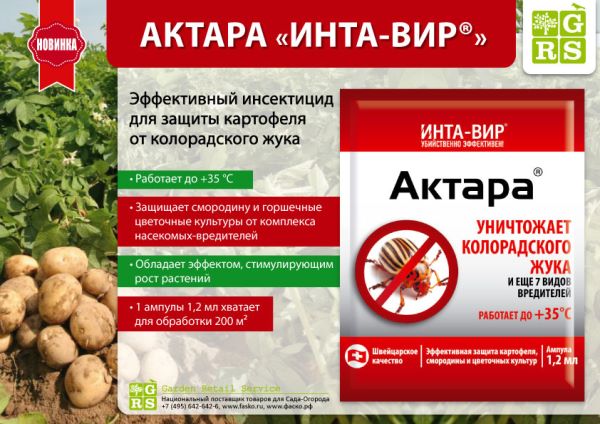
Instructions for use of the drug
For the use of the drug, various dosages are used, depending on the pest:
- Aphids, whiteflies and scale insects are often uninvited guests on ornamental crops. To carry out treatment against them, use 8 g of insecticide per 10 liters of water. When using liquid Aktara for 0.75 liters of water, 1 ampoule of an agrochemical is consumed.
- If thrips appear on roses, the working fluid is made taking into account 16 g of insecticide per 10 liters of water.
- To defeat mushroom mosquitoes and a soil fly that have settled on potted flower crops, it is necessary to dissolve 1 g of granules in 10 liters of water.
- If sucking pests have been noticed, then use Aktar, prepared taking into account 8 g per 10 liters of water. The diluted agrochemical is used to water the plants at the root.
Description of the drug Aktara
The chemical Aktara belongs to the category of new generation insecticides. Their distinctive feature is a sufficient degree of effectiveness against the main pests of indoor plantings and a high rate of impact.
Properties and purpose
The chemical preparation Aktara gained its popularity due to the following positive characteristics:
- the ability to quickly affect the pest (30-60 minutes after use);
- maintaining performance regardless of weather conditions;
- resistance to low and high humidity, sunlight;
- long-term exposure (1-2 months);
- good assimilation of the underground and aboveground parts of the plant;
- no side effect of accumulation of toxic substances in green spaces;
- economy (with a small dosage, it is possible to process several pets);
- effectiveness against most parasites;
- ease of breeding.
Application area
Spraying or watering flower crops with a working fluid based on Aktara is effective against the following parasitic individuals:
- Colorado potato beetle;
- moths;
- aphids;
- scabbards;
- soil fly;
- whitefly;
- thrips;
- May beetle;
- spider mites, etc.
In order for an insecticidal preparation to show its high effectiveness against harmful insects, it is necessary to familiarize yourself in more detail with the principle of its action and dosages.
Drug analogs
- Tiara. This insecticide helps to effectively destroy many agricultural and indoor pests.Although the main active ingredient is thiamethoxam, the action is not similar to that of Actara.
- Cruiser. This product is used to treat seeds against early and soil leaf pests. It gives a long lasting protective effect. When processing an orchid, it quickly fills all the cells of the plant. Juice is a tasty prey for pests. Having drunk it after such "transformations", the nervous system of insects suffers.
- Doctor 8 Arrows. This insecticide is produced by Firm Zelenaya Apteka LLC. It costs thirty-five rubles. Although the packaging is unattractive, it is effective. When using, the grower should carefully stick the arrows into the pieces of bark. Some rake the substrate, put an arrow in the void that has arisen and cover it with pieces of bark. Before processing, wipe the leaves with a solution of laundry soap, since the drug will only work after 7-14 days.
Tiara
The composition includes an active substance - thiamethoxam, but the effect of this agent is not similar to the healing property of Aktara.
Price - 3200 rubles. for 1 liter.
Cruiser
It has a long-lasting protective property, more suitable for the treatment of seeds and soil plants. When irrigating orchids, it instantly penetrates the cells of all organs. It affects the nervous system of parasites that like to feast on the juice of flowers.
The cost for one bottle of 5 liters is 2500 rubles.
Doctor 8 arrows
A drug of domestic production, which has a good and fast action. It comes in the form of arrows. They are carefully inserted into the substrate. After that, irrigation of the aboveground part with a solution of laundry soap is required, since the active substance begins to act on the 8th day of application.
Price - 35 rubles.
"Aktara": instructions for use
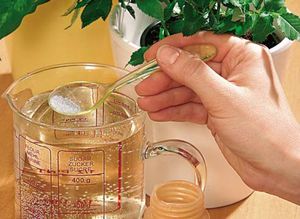 You only need to get started when you first see ticks, beetles or caterpillars. Processing should be carried out in calm, clear weather in the morning or in the evening, and only when you are sure that there will be no rain. An hour must pass after application to fix the insecticide on the leaves.
You only need to get started when you first see ticks, beetles or caterpillars. Processing should be carried out in calm, clear weather in the morning or in the evening, and only when you are sure that there will be no rain. An hour must pass after application to fix the insecticide on the leaves.
The ready-made solution cannot be stored, so the composition needs to be prepared only in the amount that you will need right away. It is best to use a knapsack sprayer that is prepared directly in the can.
Preparation of "Aktara" looks like this:
- Dissolve four grams in a liter of water at a temperature of 25 degrees in the open air.
- Fill the sprayer reservoir by a quarter.
- We pour in the concentrate in the required volume for a particular plant.
- Pour up to 5 liters of water into a container.
- Close it tightly.
- Shake the sprayer.
Application for flowers and other plants
To protect your violets, cyclamens and other indoor plants from insects, you need to dilute 4 grams of the drug in 5 liters of liquid. This will be enough for a large greenhouse. For processing a vegetable garden and a garden drug consumption for 10 liters of liquid may vary slightly depending on the type of plant:
- Currant - 2 grams.
- Tomatoes - 4 g. Watering at the root.
- Seedlings of cabbage from flea beetles - 3 g (under the root).
- Cucumbers - 3 grams when spraying and 8 grams when applied to the soil.
- Onions - 4 g. When spraying.
- Eggplant - sprinkle - 3 grams and root 8 g.
- Roses, violets or orchids - 4 g from aphids and 16 from thrips.
- Fruit trees (plums, pears or apples) - 4 g.
- Grapes - 3 g.
Shrubs and fruit trees must be processed for the first time before flowering and emergence of the beetle, for the second time after harvesting the fruit. The instructions for use contain information about the use of the drug, depending on the pest and the type of plant.
If you use the drug in the form of a liquid for different plants, you need to dilute one ampoule in the following amount of liquid:
- strawberries or currants - 6 liters
- orchids, roses and violets - 0.75 liters;
- onions - 3 liters.
To avoid the appearance of resistance of "Aktara" in the May beetle, whitefly or spider mite, its use must be alternated with other insecticides.
Planting handling
 A drug such as "Aktara" can be used for the processing of planting material. A highly concentrated solution will be required, the consumption is 4 grams per liter of water. To process potato tubers, 6 g of powder is dissolved in 0.3 liters of water.
A drug such as "Aktara" can be used for the processing of planting material. A highly concentrated solution will be required, the consumption is 4 grams per liter of water. To process potato tubers, 6 g of powder is dissolved in 0.3 liters of water.
And seeds, potato tubers, onion heads and garlic cloves must be soaked in the composition before planting. Do not be afraid of the high concentration of the product, it completely decomposes in 60 days.
After processing edible plants of any kind, they are safe for humans, after a couple of months. Soaking in the composition helps plants to take root and develop better. If they get stronger, then I will be less exposed to harmful insects.
Properties of the drug Aktara
Aktara helps:
- protect the plant from various pests,
- improve the quality of leaves and shoots.
Depending on the method of application, it is valid for 1-2 months after treatment.
Thiamethoxam - the active substance of the drug - decomposes well in the soil, dissolves in water and is absorbed by the plant from the ground. Due to these properties, the insecticide can be used both for spraying vegetative parts and for treating the soil. The complex preparation can be used for complete control of the reproduction process of various pests throughout the season.
Aktara is produced in ampoules, the use of which is more convenient than other forms - granules. However, both one and the other type of the drug are popular with summer residents. The drug is effective against most pests of garden, garden and indoor crops. Instructions for use recommend using it to kill the following insects:
- mealybugs
- mushroom gnats
- aphids
- Colorado potato beetle
- soil beetles and their larvae
- onion and carrot flies
- thrips
- scale insects
- moths, leafhoppers and suckers and many others
The tool effectively destroys insect stages that feed on plants, since if pests enter the digestive tract, it better penetrates the nerve tissues.
- There are several advantages of Aktar's remedy:
- The drug works equally well when applied to plant leaves and watering with a solution under the root
- The active substance of Aktara penetrates into the vascular system of the plant, and is distributed only in the vegetative parts. Toxins are not found in fruits, ovaries and inflorescences
- The active compound of the drug does not lose its effectiveness under the influence of sunlight, high temperatures, since it penetrates into the intercellular space of plants. He is not afraid of precipitation, even during rains, the concentration of thiamethoxam remains at its original level.
- The action of Aktara lasts up to 4 weeks when applied to leaf blades, and up to 8 when applied to the soil, which allows you to protect plants for a long time and reduce the number of treatments per season
The declared advantages and properties of the preparations are valid if Aktara is used correctly. Before using it, it is recommended to carefully study the instructions.
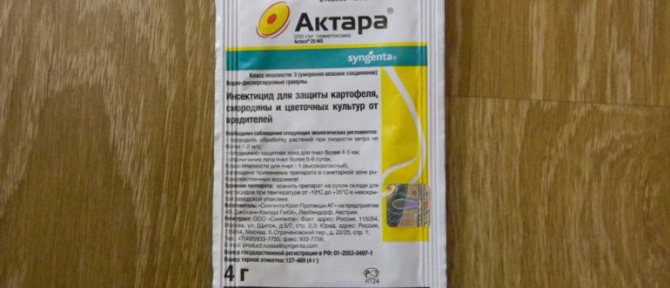
It is a crystalline powder of light cream color, odorless. Aktara is often used in agriculture. The drug belongs to the group of chemical neonicotinoids. According to the method of use, it is an intestinal-type insecticide. It is also used for treating vegetation before the flowering period, and for spraying seeds.
The drug is manufactured in Switzerland. It is noteworthy that its manufacturer, when developing it, took into account the preferences of consumers. It is for this reason that many gardeners use Aktara to protect violets, orchids, roses and vegetables on the site, as well as indoor plants.
The drug is produced in different forms:
- concentrated suspension;
- soluble granules.
The liquid is in bottles and ampoules. With their help, you can provide reliable protection for the following plants:
- violets;
- strawberry beds;
- indoor vegetation;
- orchids;
- rose bushes.

This insecticide is popular because:
- quickly penetrates into all parts of the plant;
- destroys larvae and adults;
- instantly dissolves in water and does not smell;
- the drug protects the plant from many pests for a long time;
- low solution consumption and a small number of treatments;
- long-term residual action;
- preservation of activity with an increase in humidity, temperature and dryness of the air;
- resistant to sunlight.
The average price of the drug Aktara is 150 rubles.
Instructions for the use of Aktara
Aktar is produced in the form of one percent water-dispersible granules, packaged in 1.4, 4 and 40 g, in the form of a suspension concentrate in bottles of 9, 250, 500 ml and in cans of 1 liter. Small packages of 1.4 and 4 g are designed for the convenience of processing plants at home and in garden areas.
You need to apply Aktara as soon as you find the first signs of the presence of parasites. The solution is sprayed with a knapsack sprayer. This should be done in the early morning or after 6 pm at a temperature not higher than 25 ºC, taking care not to get the solution on neighboring cultures. For the procedure, it is better to choose a quiet, fine day. If it looks like it will rain within an hour after treatment, then it makes sense to postpone spraying for another day.
Bred Aktar in the open air. First, a mother liquor is prepared: Aktara is poured into a container with a volume of 1.5-2 liters and 1 liter of water at a temperature of 25-30 ºC is poured into it. The working solution is mixed directly in the sprayer tank: it is filled with water by a quarter, then the required amount of mother liquor is added to it. For example, to process:
- potatoes will need 150-200 ml of mother liquor;
- for currants - 250 ml;
- for flower crops - 600 ml.
The volume of the working solution is brought to 5 l with water, the sprayer tank is closed and shaken vigorously so that the contents are well mixed.
For the treatment of ornamental or flower crops at the root, 1 g of Aktara is dissolved in 10 liters of water, and 8 g of the preparation is dissolved in 10 liters of water for spraying the leaves. If you follow the manufacturer's instructions and apply Aktara only on recommended crops, phytotoxicity can be reduced to zero.
Aktar is also used to process vegetable seedlings: the roots of the seedlings of nightshade crops (pepper, tomato, tobacco and eggplant) are dipped two hours before planting in the garden in a solution of the drug. The procedure is carried out at a temperature of 18 ºC. To prepare the etching composition, 1.4 g of dry Aktara is poured into 1 liter of warm water and stirred until complete dissolution, and then the volume is brought to 10 liters. 1 liter of this solution should be enough for 200-250 seedlings. The rest of the solution is poured over the garden bed after planting.
Seed material can also be treated with Aktara. For dressing potato tubers 6 g of the agent is dissolved in 0.3 l of water. The tubers are evenly laid out on a film, sprayed with a working solution, and then mixed well. It is impossible to store tubers treated with Aktara; they must be planted immediately. In the same way, onion and garlic cloves are processed before sowing.
Precautionary measures
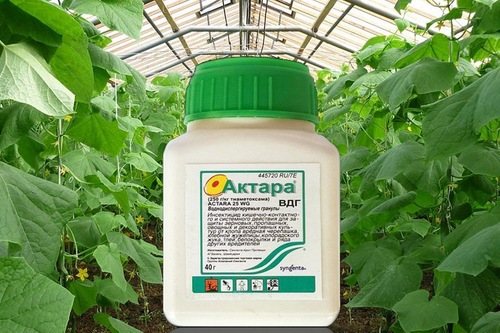
It is a class III insecticide. It has low toxicity, but during work and during the preparation of a working solution, it is required to observe safety measures:
- protect the respiratory system with a respirator;
- exclude contact with eyes - wear safety glasses;
- work in a work suit that covers the skin of the hands and feet;
- wear rubber gloves.
Important!
Requirement for weather conditions: weak or no wind, no precipitation, dew, bright sun.
The effectiveness of the drug and its safety depend on the weather. The rain that has passed after spraying will wash away the insecticide. The wind will reduce its concentration on the leaves of cucumbers, because of it splashes can get on the skin of the face. Due to the frequent use of the drug Aktara in the country, the number of earthworms is decreasing.
The insecticide is dangerous for bees - hazard class I, so it should not be used near apiaries. Protective zone - 4-5 km. After processing with Aktara, cucumbers pose a threat to wasps, bumblebees, and bees for 96 hours.
Scheme of action
Possesses intestinal contact action, systemic and translaminar activity. That is, it effectively acts on pests both from the outside - when it hits the surface of the body, and internally - when the parasite uses parts and juices of the etched plant.
Symptoms of the drug appear after 10 minutes. After the first 30 minutes, as a result of intestinal upset, insects stop feeding, death is observed in 24 hours.
There is no possibility of the appearance of resistance if these recommendations are followed, however, with active use, it is better to alternate with other substances (pegasus or actellic). However, in a small greenhouse or apartment, this is not necessary.
Due to the rapid absorption of the drug by the plant, within 20 hours, it is distributed throughout the plant body, partially accumulating.
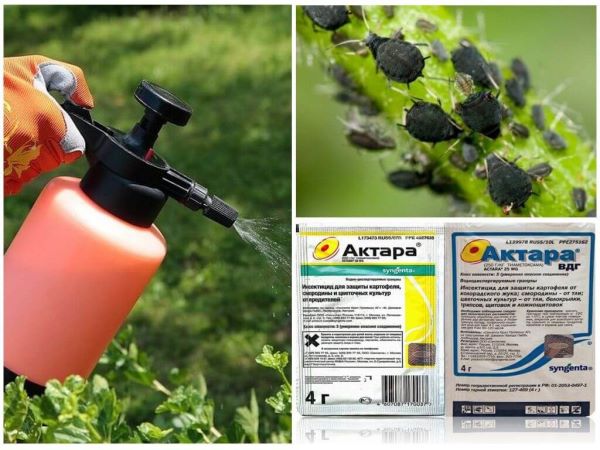
The metabolism of the substance is slow, which determines its long-term protective effect, which is approximately 3-4 weeks, with soil application this period increases to 7 weeks.
In addition, this method will make it possible to use predatory insects for their own purposes, which can live on your plants. Below you will learn how to treat an orchid with this preparation.
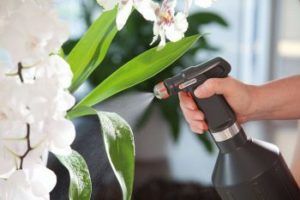
What is Aktara insecticide?
Insecticide Aktara is a new generation drug that can be characterized by fast action and very high efficiency. This product is a reliable plant protection for a long time, usually 25-55 days.
It all depends on the method and norms of application. Experts have confirmed that this drug belongs to the class of low-toxic pesticides.
Most often it is used when spraying vegetables and grain crops, berry bushes. The insecticide Aktara is classified as an enteric neonicotinoid.
The drug Aktara insecticide is a new generation drug created on the basis of thiamethoxam. It is the main active ingredient with a broad spectrum of action. The aforementioned agent works both when applied to the soil and when surface treatment of plant leaves.
The release of this drug is carried out in several forms:
- in the form of a liquid concentrate in a container with a capacity of 9 ml, 250 ml, 1 liter;
- in the form of water-dispersible granules, which are packaged in polymer bags 1, 2 and 4 grams;
- in the form of a soluble powder, which is packed in foil sachets of 4 grams;
- in the form of tablets in special blisters.
The highest percentage of thiamethoxam (the main active ingredient) is contained in liquid form, and the lowest in tablet form (only 1%).
Instructions for use
Aktara belongs to the chemical class of neonicotinoids, acting on the nicotinic-acetyl-choline receptors of the insect nervous system. The active ingredient, thiamethoxam, penetrates mainly into the leaves through the vascular system, practically does not enter the fruits. At the same time, the drug is completely redistributed through the tissues of the leaves of the plant 20 hours after watering. When watering large plants with Actara, after 1 - 3 days the solution reaches the upper stems and shoots. Aktara is resistant to sunlight, does not reduce efficiency in dry air or rainy weather. The period of protective action is 14 - 28 days for spraying on the leaf, 40 - 60 days - for soil application.
There is a possibility of the emergence of resistance (studies have shown the addiction of pests during repeated treatments), in particular, repeated outbreaks of damage by worms and whiteflies occur. This is also explained by the fact that the actara acts on the larvae, i.e.only at the feeding stage, if the root ball is not evenly moistened, the larvae hatched from the eggs can remain in the ground. And with each watering, the earth gets rid of the traces of the insecticide. To prevent resistance, it is recommended to alternate the actara with insecticides from other chemical groups. Aktara is compatible with most insecticides, fungicides, and growth regulators (Zircon, Epin, Oberig), except for preparations in which the solution has an alkaline reaction (Bordeaux mixture, soap, lime).
Conclusion and tips
Obviously, Aktara is the # 1 drug for hand-to-hand combat with parasites. It is versatile, has a wide range of effects and is applied in flexible ways. Overdose is practically excluded.
It has no analogues in its kind. Recommended for pest control on indoor plants, in particular on orchids, as well as on horticultural and horticultural crops. Poison insects wisely and enjoy orchids.

